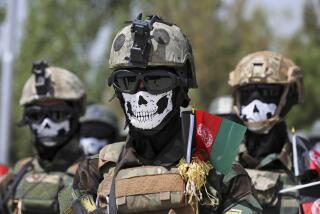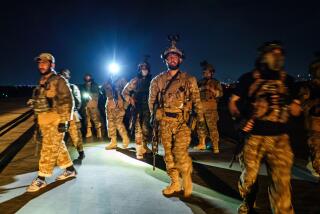Afghan force faces crucial test in Marja
- Share via
Reporting from Kabul, Afghanistan, and Camp Leatherneck, Afghanistan -- The effectiveness of the alliance between the U.S. military and Afghanistan’s security force rests on a particularly delicate question: Will sufficient numbers of Afghans put up a good fight against the Taliban -- starting very soon?
Army Gen. Stanley A. McChrystal’s strategy to reduce the U.S. role in Afghanistan includes increasing the training of the Afghan force, doubling its size and enhancing its capabilities. How realistic that strategy is remains to be seen, particularly in light of President Obama’s preference that the United States begin withdrawing troops in mid-2011.
An offensive expected soon to seize the Taliban stronghold of Marja -- an insurgent haven and a hub of the narcotics trade in violent Helmand province -- would serve as a strong boost to Western efforts to create a robust national security force, if Afghan troops demonstrate competence and courage in the field.
But such a deliberate effort to showcase the Afghan force’s role in a high-profile assault carries heavy risks as well. A lackluster showing in Marja by the Afghans would be a propaganda coup for the Taliban and a blow to hopes that a Western military drawdown can begin next year.
In July, when Marine battalions swooped into the Helmand River Valley, the Afghan contingent accompanying them was less than one-seventh the size of the U.S. deployment -- about 600 Afghan police and soldiers to about 4,500 Marines. Marine Brig. Gen. Larry Nicholson complained publicly about the lopsided numbers, saying more Afghan soldiers were needed.
As the Marines seized a swath of the valley, tensions emerged with their Afghan allies. Some of the Afghans fought bravely, but others hung back, reluctant to move to the front lines. Once the Marines had established a foothold in a string of villages, field commanders were frustrated by their inability -- because so few Afghan counterparts were on hand -- to communicate with the villagers they were trying to win over.
This time around in Marja, commanders indicate, a greater proportion of the troops will be Afghan. The size of the American assault force has not been disclosed, but Brig. Gen. Eric Tremblay, spokesman for NATO’s International Security Assistance Force, told reporters that there would be more than 1,000 Afghan police officers and thousands of Afghan army soldiers.
And the Afghan forces will play a more important role in engaging Marja’s overwhelmingly Pashtun population of about 85,000. Gen. Mohammed Zahir Azimi, a spokesman for the Afghan military, told reporters in Kabul, the capital, that a key role of the Afghan troops would be to help “separate the local people from the terrorists.”
More than military pride is involved. One of Afghan President Hamid Karzai’s many challenges is to convince the population that his government is strong enough to fight the Taliban. A show of force by Afghan soldiers also might persuade low-level Taliban fighters to quit the insurgency.
Marines involved in training the Afghans are careful in their assessment of their allies.
“They may rely on us for a little push, but they will fight,” Marine Master Sgt. Anthony Greene said.
Yet many obstacles remain to building a force strong enough to contain the insurgency.
With troop strength at about 100,000, the Afghan army consistently has trouble meeting its recruiting goals. Pay has improved but is not much better than what the Taliban can offer its foot soldiers, and the caliber of recruits is still considered poor. Drug use and illiteracy are less pervasive in the army than in the police ranks, but they are common enough to pose a serious impediment to training.
And logistics, the complex task of supplying front-line troops, has been a difficult lesson to teach, Marine spokesmen said. The Afghan army is often short of ammunition, its artillery rounds are old, and vehicle maintenance is spotty.
The U.S. has tried to teach the Afghans the advantage of investing authority in senior enlisted personnel. But the Afghan army remains a top-heavy organization, with senior officers often not delegating authority or sharing information, much in the style of the Russian military that occupied the country for years.
Yet as the Marja offensive approaches, Afghan generals insist that their troops, though young, will prove themselves.
“We are ready,” said Brig. Gen. Mahayoodin Ghoori, who will lead Afghan troops.
More to Read
Sign up for Essential California
The most important California stories and recommendations in your inbox every morning.
You may occasionally receive promotional content from the Los Angeles Times.










